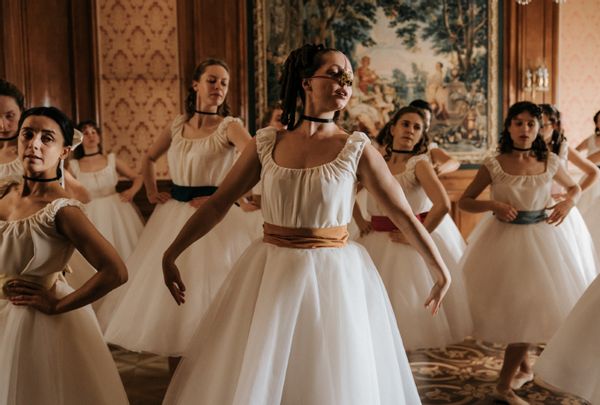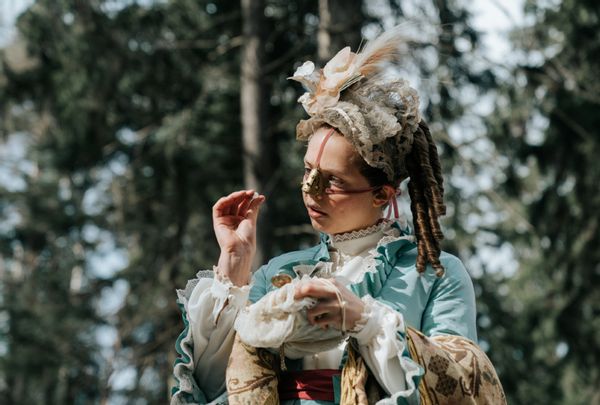
“The Ugly Stepsister,” written and directed by Emilie Blichfeldt, takes its cue from “Cinderella,” but this inspired body horror comedy is no Disney film. This fairy tale is both Grimm and grim — and not unlike “The Substance” in the main character’s quest for beauty at any cost.
Elvira (Lea Myren) dreams of marrying Prince Julian (Isac Calmroth) even before he knows who she is. When her mother Rebekka’s (Ane Dahl Torp) new husband Otto (Ralph Carlsson) dies on their wedding day, the family’s assets are seized. The only way out of poverty is for Elvira to marry a wealthy man. But with braces on her teeth and a nose in need of rhinoplasty, getting Prince Julian to notice her at the Ball, where he will choose his bride, is going to be difficult. But Rebekka is determined to live well, and rather than bury her husband, she leaves his corpse to rot and invests in Dr. Esthétique (Adam Lundgren, marvelously campy) to improve Elvira’s looks. The faint of heart will want to close their eyes when he sews on eyelashes in one of several squirm-inducing sequences.
“Beauty is pain,” Dr. Esthétique explains, and “The Ugly Stepsister” gets more violent and disgusting as Elvira gets more exquisite (with the help of a nasty and very hungry tapeworm). Blichfeldt films all this with an unblinking eye, satirizing the lengths women go to in order to reach the standards of beauty they feel they must achieve.
“The Ugly Stepsister” won the Audience Award at the recent Overlook Film Festival, and it's best seen in the theater with a crowd, especially during its more potent moments. Blichfeldt spoke with Salon during Overlook about making her delightfully disgusting debut feature.
Since this is your feature film debut, can you discuss how you came to make films?
Cinema came quite late in my life. Many filmmakers who are movie buffs have been lovers of movies since they were kids. My family was all about books. I grew up in Northern Norway, far away from anything pop culture. We got our first VHS and DVD player when I was 13. When I started watching movies, I fell in love with “Amélie,” and became obsessed with it because it is a movie that plays with form — music, locations, camera movements — all things that are cinema. When I did drama in high school, I moved from home and rented films. Struck by Nicole Kidman’s face, I rented “Dogville” at the age of 16, and that was shocking to me in the best way. I thought, “If this is cinema, I want in.” I started doing films after school at a youth center. I understood I didn’t want to be in front of the camera, I wanted to be behind it.
What inspired you to retell “Cinderella” as a body horror comedy?
I didn’t choose “Cinderella,” or the stepsister, the story of “Cinderella” through the stepsister chose me. It was an idea I had in a creative nap. I envisioned a chubby, beautiful woman struggling with the beauty ideal. And in this nap, I envisioned her as Cinderella, fitting the shoe, to my surprise. And still in a dream state, she sees that the shoe is full of blood. Of course, I’m not Cinderella. I am the stepsister. When I woke up, I was in shock. I could relate to those feelings of shame and despair she felt when she realized she was the stepsister. She tried to fit in, and she failed. But it was this overlooked, ridiculed character that I saw myself in. I had never been in her shoes before — pun intended — and that was a great revelation to me. From that moment, I knew it was going to be a body horror. That got me really excited because I had gotten into [the genre] a few years prior and have totally fallen head over heels for everything body horror. The balance of campy fairy tale, beautiful dresses, body horror, and gore — that mixture was what I really wanted to play with to make a cinematic experience that would lure people in and have a great time, but also make sure that it was carrying my message.

When I was developing the script, people were nagging me about it being a modern fairy tale, and why I did not set the film “today.” But that is not what this is about. What I found in this fairy tale is that the stepsister is the most relatable character and has been for thousands of years. I knew I wanted it to feel like an old fairy tale to keep that perspective and even trick a less literate audience into thinking that this is maybe the real story — hack other people’s relationship to the fairy tale.
We have a Czech version of the fairy tale called “Three Wishes for Cinderella.” It is a tradition in Norway and Germany to see this film every Christmas. It is beautiful in its uncanny realism. So many fairy tales today are so glossy and unreal that they don’t have a real impact. I wanted to give my film the grittiness of reality, but still keep it heightened and fantastic. So, through that movie, I dive into the ‘70s, especially in Eastern Europe. I found this amazing “Beauty and the Beast” version, and erotic fairy tales. It is the uncanny mixture of campiness and reality. The ‘70s works as a lens that makes sure our tastes and fashion of today are obscured when we look into the 1800s.
Your film is a dark comedy of manners about propriety — the finishing school, but also the prince and his friends — as well as about how characters who are “othered” behave. What observations are you making about society and how it has or hasn’t changed over the centuries?
There is a lot of two-facedness out there. There is a lot of doublespeak, that as women, we have never been as emancipated and free to do what we want as we are today. Hopefully, we will keep moving in that direction because the winds are turning in our world right now, which is really scary. As a young woman, I was told that I am free and can choose to do what I want with my body, but what I am trying to say is that although legally we are emancipated in a lot of the world, our culture is still dragging with it ideas that date back thousands of years. It is only just 100 years since women got the right to vote, and before that, they were owned by men. The only way to get somewhere in life was to please the male gaze as an object of desire, to give birth, and have sex. We have not dealt with women’s historical objectification in our culture. We are not aware, or it is not part of our conversations about the struggles we are facing with the tyranny of beauty. It’s not that I think we should become like men, or behave like men, but we have to bring that into the conversation.
You are certainly commenting on beauty as Elvira undergoes a series of painful procedures to change her outside to match her inside. Do you think your film will change minds about how we strive for beauty ideas?
I really hope so. I think the big realization I had quite early was that almost all girls are fed this princess fantasy, and this is what you dream — to become a beautiful woman some rich handsome man will choose. This is putting our value in our looks, and that’s what you should strive for: to be this beautiful, gracious woman. But I realized there is only one Cinderella. There is only one ideal. It’s changing all the time, but most of us will not fit that shoe. We are stepsisters. I hope the film makes people understand that it is ridiculous. There is only one Kate Middleton who can marry the prince. The rest of us have to find something else to do in life, and not in our looks. If you put your value in your looks, you are less free to play with it and change it up and do what you want. I hope that is what people take away.
“Beauty is Pain” is a key theme here. Elvira goes to several extremes to improve her appearance. Can you explain how and why you came up with the eyelash sequence, which you shot in excruciating close-up, and the truly disgusting tapeworm? How far was too far?
I didn’t know how far was too far. What, for me, separates splatter gore from body horror is that body horror always carries meaning. I needed it to be integrated into the story. I needed the story to deserve it. The different procedures, like the sewing of eyelashes, I think that’s an urban legend. It is based on research. It doesn’t have to be totally real because it is a fairy tale, but I wanted folks to not be sure. It was based on a notice in a late 1800s newspaper, which said that the newest fashion in Paris is sewing in eyelashes with a needle and thread and using cocaine for pain relief. I thought that was a gruesome and cool idea. It reminds us of what women are doing now. It was also important to make an eyelash extension that had a different feel to it — the Twiggy ‘60s thing — so if anyone had [sewn] eyelashes, it didn’t feel like I was pointing at them.
The tapeworm was also from research. I wanted her transformation to be about weight and eating, which is part of many women’s struggles with fitting in. The tapeworm diet was, of course, gross, but it would have felt a bit unrealized if she just took it and became skinny. I had the epiphany that what goes in must come out; I found a meaning it could carry. For me, up to the point where she [swallows] the egg, she has been the victim; people have objectified her and done stuff to her. This is the first action that she does to herself. It is a metaphor for how she internalizes the external gaze and starts self-objectifying. As the worm grows in her stomach, it eats her up metaphorically and literally from inside, which is what self-objectifying is. I knew when it needed to go out, it would be a big cathartic moment, and it needed to be shocking to see how big it had grown. It needed to become this monster. As for how far to take it, I used myself as the first audience.

It was shocking to me when I realized that Cinderella was sexually active. This was a realization that made me understand her as a character beyond the archetype. She has a natural beauty, but she is a natural in everything. She has no shame. She is a woman having sex. It is not problematic or difficult. But for Elvira, everything is hard and difficult. I could relate to that. I had friends who would naturally start dating and have sex, and I was left on the side, wondering, "How do they do this?" I didn’t understand it at all. I knew Cinderella being sexually active was going to be shocking for the audience and for Elvira to see, since she doesn’t know what sex is. I wanted to describe sex that was natural, erotic and as shocking as it can be. That was a lot of fun. And that is my sense of humor — to show a vagina and a penis and show this is how it happens.
When she first sees the prince, she isn’t quite sure what she is seeing. She’s intrigued, but it’s not proper, and yet she is still aroused.
As a young woman, especially in that time, there is so much of the world that is hidden. You are not supposed to take part in that, or have those images in your head, or want eroticism. But that is a part of human nature. There is a lot of mixed emotion in these young girls. Even today. This is not part of the conversation in the narratives they are told.
The film also expresses interesting ideas about love, as many of the characters are looking for money, not necessarily romance. For Elvira, love is a fantasy, but for her stepsister, Agnes (Thea Sofie Loch Næss), who loves the stable boy, Isak (Malte Gårdinger from “Young Royals”), it is an impossibility. All the other sexual relationships seem to be transactions. Can you discuss this?
There is the theme of class in the film. We say that the “Cinderella” story is rags to riches, but in all versions, especially the European ones, she is a noble girl put into the kitchen by her wicked stepmother. It’s more riches, into the kitchen, and then to riches again. That was an important piece I wanted to remind people of. Cinderella always has class. She had a noble upbringing, was well fed and had loving parents. The stepmother is a single mom and a widow at a time in history when her only way to secure money is through her body and her sexuality, and by marrying. It is very transactional. Marriage has been that for so long. I think it is funny to put that in there. The whole marrying a prince thing has been very transactional and not so romantic.

And see how that went! That didn’t go well.
What can you say about the use of sound in the film? The tapeworm rumbling is amusing, as are the sound effects of some of the gore. On the soundtrack, you feature harp music, which is very appropriate for some scenes, but you also use anachronistic synth on the soundtrack to give the film a real vibe.
What is funny is that we pulled back a lot in the sound design of the gore. With a lot of gore sound, it was telling the audience too much and how they should feel, so it felt less horrible. I wanted the audience to lean in to be there. When the sound then comes, you are so invested, you go “Ugh!” It was fun to make it really realistic. With the music, we also went for a ‘70s feeling with the harps and synths, but in the editing, we wondered if people would understand that we know this is camp. It became a pastiche of ‘70s music and the ‘70s take on the fairy tale. We had this idea that we wanted to put some more modern music on it, so it still felt like 2025, and that there is a storyteller who knows what she is thinking about in this moment. That’s my secret language with the audience. It makes Elvira’s feelings more modern.
How does the film play in Norway? Is there a universal appetite for “The Ugly Stepsister,” or do you think the film is more of an acquired taste?
It’s in cinemas in Norway now. The arthouse 40-something audience is a bit on the fence about the grossness. But young girls are eating it up — hopefully not the tapeworms — and that for me is a dream come true. That is my number one target audience. That is everything for me.
“The Ugly Stepsister” opens April 18 nationwide.







